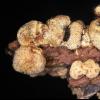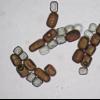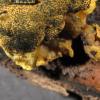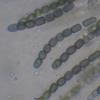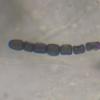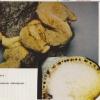
24-12-2025 17:08
Hulda Caroline HolteHello, I have found this propoloid ascomycete on

21-12-2025 09:32
Hello.A tiny ascomycete found embedded in wood in

21-12-2025 21:32
Pol DebaenstHello, Garden, Burgweg 19, Veurne, BelgiumOn 10/1

22-12-2025 23:38
Patrice TANCHAUDBonsoir, récolte sur un mur en pierre, apothéci

22-12-2025 00:47
Patrice TANCHAUDBonsoir, récolte à proximité du milieu dunaire
Thuemenella cubispora
John Plischke,
01-07-2012 10:53
 I am looking for a detailed description of Thuemenella cubispora = Hypocrea cubispora. So far I have found Taxonomy of Thuemenella (Chromocreopsis) cubispora Mycologia 77 (2) 1985 272-277. But it does not answer some of my questions. I see that it is yellow but can it have orange tones also? Can it bruise orange where injured? Can the wood around it look to be covered with an orange brown colored crust that can bleed red where injured and is this part of it?
I am looking for a detailed description of Thuemenella cubispora = Hypocrea cubispora. So far I have found Taxonomy of Thuemenella (Chromocreopsis) cubispora Mycologia 77 (2) 1985 272-277. But it does not answer some of my questions. I see that it is yellow but can it have orange tones also? Can it bruise orange where injured? Can the wood around it look to be covered with an orange brown colored crust that can bleed red where injured and is this part of it?Thank you,
John
Jacques Fournier,
01-07-2012 15:50

Re : Thuemenella cubispora
Hi John,
first let me apologize for my answer to your question on Xylaria cubensis, I thought you were from Germany! As reported by Rogers this species is not that rare in northern parts of the US though it is basically a tropical taxon.
I have never seen fresh material of T. cubispora but judging from its habit with orange bown tones when dry I can easily imagine its yellow color turns somewhat orange when bruised. I have seen a specimen growing on Hypoxylon rubiginosum (photos attached), which might account for the discolored substrate.
Could you show us some photos of your find?
Cheers,
Jacques
first let me apologize for my answer to your question on Xylaria cubensis, I thought you were from Germany! As reported by Rogers this species is not that rare in northern parts of the US though it is basically a tropical taxon.
I have never seen fresh material of T. cubispora but judging from its habit with orange bown tones when dry I can easily imagine its yellow color turns somewhat orange when bruised. I have seen a specimen growing on Hypoxylon rubiginosum (photos attached), which might account for the discolored substrate.
Could you show us some photos of your find?
Cheers,
Jacques
John Plischke,
01-07-2012 21:41

Re : Thuemenella cubispora
Hello Jacques,
Your answer to my questions was very helpful and and answered everything. Thank you. Thuemenella cubispora is rare here in the United States and has not been recorded in Pennsylvania the state where I live. I checked all the herbarium records for PA today and there are none. I also went back this morning to photograph it and to check to see if it was growing on Hypoxylon rubiginosum and it was. I now wonder how often it grows on the Hypoxylon and if it is fungicolus.
Thank you,
John
Your answer to my questions was very helpful and and answered everything. Thank you. Thuemenella cubispora is rare here in the United States and has not been recorded in Pennsylvania the state where I live. I checked all the herbarium records for PA today and there are none. I also went back this morning to photograph it and to check to see if it was growing on Hypoxylon rubiginosum and it was. I now wonder how often it grows on the Hypoxylon and if it is fungicolus.
Thank you,
John
Jacques Fournier,
01-07-2012 23:02
Jason Karakehian,
02-07-2012 12:38
Re : Thuemenella cubispora
Hi John, I found this fungus in Bradley Palmer State Park in Topsfield, MA last year around late July. It too was on a xylariaceous fungus but I didn't know what it was until now and will reexamine my specimen. The two papers I looked at was Persoonia 3(1)pp 1- 7, 1964 by K. B. Boedijn The Genus Thuemenella with remarks on Hypocreaceae and Nectriaceae. The other was Mycologia 84(1) pp. 26-40 1992 by Gary J. Samuels and Amy Y. Rossman Thuemenella and Sarawakus. Best -Jason
francoise candoussau,
03-07-2012 20:44
Re : Thuemenella cubispora
Bonjour John,Vous trouverez la description de "Tcubispora au Gabon" dans MYCOTAXON 12-2-503-508(1981)d'après une récolte de GGILLES monregrétté collègue qui me l'avait envoyée et qui a pu observer sur place son développement.L'espèce débute par des petites masses abricot-rouge 2-3mm. puis grossissent en prenant une forme irrégulière pour devenir franchement jaunes.Depuis cette publication lespèce a été versée dans les XYLARIACEAE par JD.ROGERS.Salutations amicales.Françoise.

